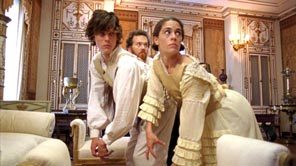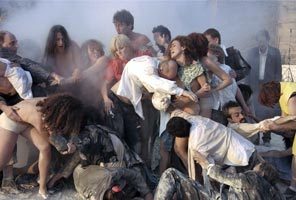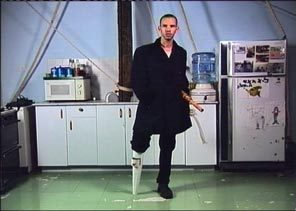Originally published Tuesday, January 6, 2009 at 12:00 AM
![]() Comments (0)
Comments (0) ![]() E-mail article
E-mail article ![]() Print view
Print view
Books, paintings become video art in two exhibitions
Video installations, including the Henry Art Gallery's "Adaptation" and Jack Straw's "Still Point," explore possibilities of adaptation from an odd assortment of media.
Seattle Times book critic
"Adaptation"
Work by Guy Ben-Ner, Arturo Herrera, Catherine Sullivan and Eve Sussman & The Rufus Corporation, 11 a.m.-5 p.m. Tuesdays-Sundays, open until 8 p.m. on Thursday, through March 22, Henry Art Gallery, University of Washington, Seattle; $6-$10, free on Thursday (206-543-2280 or www.henryart.org)."Still Point"
Work by Heather Dew Oaksen, 9 a.m.-5 p.m. Mondays-Fridays through Feb. 12, Jack Straw New Media Gallery, 4261 Roosevelt Way N.E., Seattle; free (206-634-0919 or www.jackstraw.org).It's a commonplace for novels to be adapted for film or the stage. It's rarer for a book such as "Moby-Dick" to be reimagined as, say, a 12-minute silent video.
That's one item on view at the Henry Art Gallery, where literature, painting, film, ballet and e-mail spam provide inspiration for a new show titled "Adaptation." A few blocks away, at Jack Straw Productions, something similar is going on with Heather Dew Oaksen's "Still Point."
Give yourself plenty of time to view these exhibits, especially at the Henry, where some of the work approaches feature-length. Here's the lineup.
At the Henry
"Triangle of Need" by Catherine Sullivan (16 mm film transferred to digital media, 2007, 56 minutes): Sullivan's beautiful three-screen installation follows several narratives, including one triggered by an e-mail scam familiar to anyone who owns a computer. As the "stories" diverge and intersect in unpredictable ways, Sullivan makes striking use of sound, dance and text. Her performers — including a few who play the last surviving Neanderthals — hold the screen with the power of silent-film stars. The score by Sean Griffin, choreography by Dylan Skybrook and the subtitled "click" language spoken by the actors all heighten the strangeness of Sullivan's imaginative world.
Shot mostly on the opulent Vizcaya estate in Miami, "Triangle of Need" has an atmosphere akin to Alain Resnais' "Last Year at Marienbad." Its visual flair recalls the work of Matthew Barney (the "Cremaster" series) and Peter Greenaway ("The Pillow Book").
"Moby Dick" and "The Wild Child" by Guy Ben-Ner (single-channel videos, 12 minutes and 17 minutes, 2000 and 2004, respectively). Lighter fare — and thoroughly beguiling. Ben-Ner stages his work, in which he stars along with his children, in his kitchen. Humor and homemade ingenuity fill these quickie versions of the Melville classic and a story made famous by François Truffaut's film, "The Wild Child" (1970).
"The Rape of the Sabine Women" by Eve Sussman & The Rufus Corporation (single-channel video, 2007, 83 minutes). Inspired by the Roman legend portrayed in Jacques Louis David's painting, "The Rape of the Sabine Women" (1799), this work has a crisp HD look and an atmospheric surround-sound score by Jonathan Bepler that uses everything from a bouzouki ensemble to a "coughing choir." As in "Triangle of Need," the performances recall the silent-film era (there's no dialogue).
Shot in Germany and Greece, "Sabine Women" starts on a thwarted testosterone note, as restless men in suit-and-tie pace the lifeless surroundings of Berlin's Pergamonmuseum, Tempelhof Airport and S-Bahn (where inaccessible women mill around on railway platforms as train-trapped men speed past). The disconnections depicted here strongly echo the work of Italian filmmaker Michelangelo Antonioni (notably "L'Avventura"). The film's leisurely pacing takes patience, but the payoff, when erotic tensions explode, is worth it.
"Les Noces" by Arturo Herrera (projected black-and-white drawings, 25 minutes, 2007). Herrera's rapidly projected abstract drawings, accompanying Igor Stravinsky's 1923 dance cantata, are more interesting for their pacing than their content. Still, this is a great way to hear "Les Noces" — loud, in the dark, with patterns flashing past you.
At Jack Straw
"Still Point" by Heather Dew Oaksen (multichannel projected videos and sound installation, on continuous loop, 2008). The Seattle artist takes string theory, T.S. Eliot's "Four Quartets" and an unrealized "happening" by Fluxus artist Allan Kaprow (1927-2006) as the starting points for this hypnotic work. The actions of six performers — shifting into view, fogging glass with their breath — are projected in two streams of imagery onto layered, translucent scrims. To a backdrop of ambient sound that's half-industrial, half-chantlike, visual passages are echoed, phased, repeated, coincide. Result: a fascinating meditation on possible multiple existences and timeless moments within the stream of time. Oaksen discusses her work at 7 p.m. Jan. 23.
Michael Upchurch, Seattle Times arts writer
Copyright © 2009 The Seattle Times Company
![]() E-mail article
E-mail article ![]() Print view Share:
Print view Share: ![]() Digg
Digg ![]() Newsvine
Newsvine
![]()
UPDATE - 02:35 AM
Wyeth's death reignites debate over his legacy
Art review | Entrancing works of Michael Dailey at 2 galleries
This "Turn of the Screw" could be tighter
"Free Friday Night Live!" at Everett's Imagine Children's Museum
$20.09 Inauguration ticket special at 5th Avenue Theatre


Exclusive Trailer: An Inaugural journey
78-year-old Bertha McDaniel and her nephew Terry Hayes are making the journey to Washington D.C. for the Presidential Inauguration.
AP's News Minute
All of today's news in one minute.
shopping

events for Saturday, Jan. 17th
- Spaahh at Hotel 1000 Facial Special
- Buffalo Exchange Party Like It's 1974!
- Art of Framing Open House
editors' picks
More Shopping Guides- Q&A | If e-mail links on fritz try fixing Windows
- All 155 survive plane crash in Hudson River
- Huskies win easily at Oregon, Jon Brockman gets rebound record
- Settlement allows Tony Wroten to remain at Garfield
- Treasury, Bank of America agree on bailout
- Details of woman's disappearance unclear
- Retail Report | Shopping centers face bleak times as retailers fall victim to recession
- Huskies make it official with four more football coaches
- GPS leads to dead truck driver in Moses Lake
- Faulty gauge had role in judging river capacity
- Israel pounds new Hamas targets, enlists reserves
 305
305 - Murder trial to begin for UW student in Italy
 111
111 - Federal Way students need inauguration permission
 72
72 - No new students at UW in Seattle this spring
 65
65 - Apple Cup, Cal games moved back, Arizona also moved
 63
63 - 2 people injured at Monster Jam truck show
 57
57 - Friendless in Seattle: A popular Web site is used for relief from our chilly social scene
 53
53 - Roderick staying at Utah
 44
44 - Mayor Greg Nickels: Federal stimulus bill will fund Mercer Street rebuild
 42
42 - January answers, volume 10
 40
40
- No new students at UW in Seattle this spring
- 30-year mortgage rates drop to lowest mark, below 5%
- Friendless in Seattle: A popular Web site is used for relief from our chilly social scene
- Restaurant review | Traunfeld's Poppy tempts with well-spiced small dishes
- Fire at landmark Alki restaurant blamed on Christmas lights
- Local inauguration festivities start early Tuesday
- Library use jumps in Seattle area; economy likely reason
- Q&A | If e-mail links on fritz try fixing Windows
- Child injured at monster truck show dies
- No new students at UW in Seattle this spring





